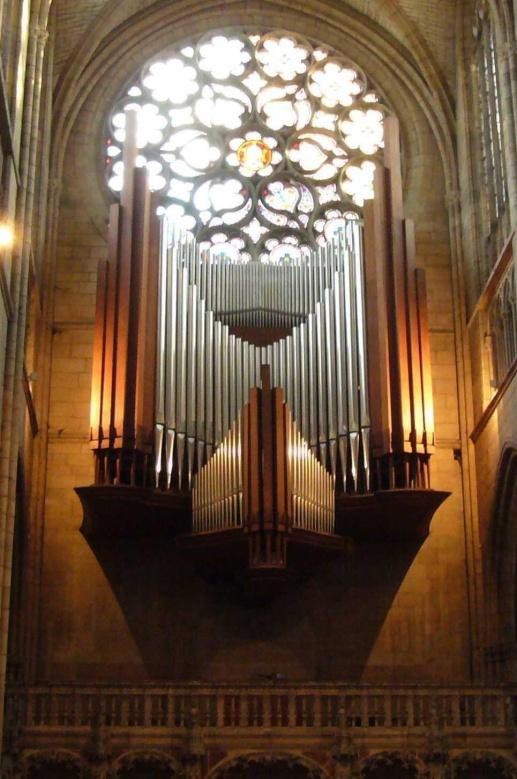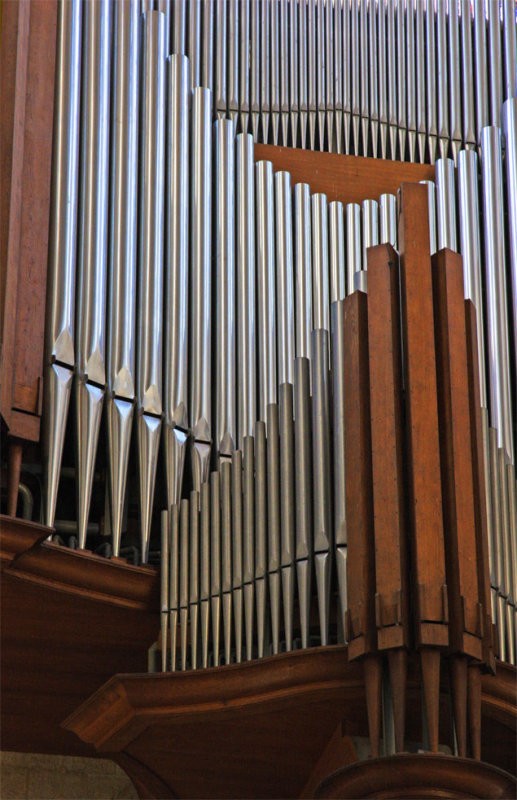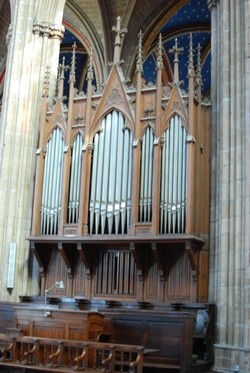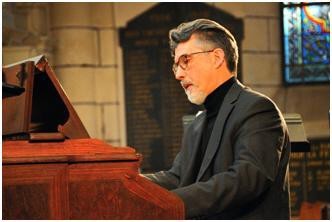THE GREAT ORGAN (DANION-GONZALEZ)

The cathedral’s Danion-Gonzalez organ, built in 1963, is unique and exceptional for its aesthetic quality. It was restored in 1986, when it received its final 50 stop composition :
3 keyboards (61 notes) and pedal (32 notes). (Electric blower for notes and stops).
In July 1958 the local administration decided to request estimates for the restoration of the organ from organ builders ROETHINGER, GONZALEZ, JACQUOT-LAVERGNE and HAERPFER.
The Gonzalez estimate was accepted. The great organ was then built with 30 stops. (Only with the 1986 restoration will the instrument receive its 50 stop final composition). It was inaugurated on December 13th, 1963 by organist Noëllie PIERRONT in the presence of the representatives of civil administration and religious authorities and a huge crowd. The bishop of Limoges, Mgr RASTOUIL, could at last -after some 25 years of legal proceedings- give his benediction to the Great Organ of the cathedral.
In 1986 it had become practically impossible to play the instrument so that a restoration was decided upon, and the great organ equipped with a Swell keyboard : after 23 years the wishes of the 1963 commission were at last fulfilled and the great organ completed.
Case and platform
Chief architect Jean CREUZOT (1896-1972) who, after World War II, had been responsible for stopping the installation of the organ presented by Mgr Rastouil, was given the task to conceive a case separate from the roodscreen. His idea was to build a reinforced concrete double platform supported by strong corbels and to place there –like a bird’s nest- a tall organ, the top of its case fitting in with the curved shape of the great western rose-window. It was to be completed by a chair-organ (« positif de dos »).

Specifications
Great : | Positif : | Swell : | Pedal : |
All couplers :16’,8’,4’. --Manual/pedal board couplers (« Tirasses») : Great division, Positiv, Swell (8’, 4’). --480 electrical combinations. --Tutti general, full-chorus (plein-jeu).
THE CATHEDRAL’S CHOIR ORGAN (DUCROQUET-MERKLIN)
In 1850 the estimate requested from organ builder DUCROQUET was accepted by the Ministry of Cults, provided some changes were made in the specifications. Concerning the organ case the builder suggested a provisional plain façade bare of sculptures to be replaced at the completion of the choir woodwork. However, the sides and the back were to receive iron reinforced panels which would remain in place ; the façade alone would have to be changed. In October 1890 a restoration estimate was presented by the bishop of Limoges to the Ministry of Cults, including the building of a case. It was accepted and the work done. The DUCROQUET organ was updated, concerning harmonic generation, and the crowning point was the installation of the present organ case.

History of the organ
-1850 : : instrumental part (Ducroquet).
-1891 : : organ case and alterations (Merklin).
-1925 and 1940 : addition of electro-pneumatic action for the swell basses (Robert Boisseau)
-1937 : Mentioned by Cellier and Bachelin for its sound quality (in L’orgue). As far as 1963 it was the only organ in the cathedral.
-20th August,1991 : Classification as Historical Monument
Characteristics : 16 stops : 2 keyboards (54 notes) and pedal board (30 notes).Mechanical action for the notes and pneumatic action for the stops.
Specifications
Great | Swell: | Pedal: |
François DUPOUX, titular organist
François Dupoux’s musical education began with studying the piano at the Conservatory of Limoges, then at St Cloud, under the tuition of Agnelle Bundervoët, where he was awarded the prize of the Union des Conservatoires de l’Île de France. Parallel to his studies in Musicology at the Sorbonne, he studied Harmony with Yvonne Desportes, Accompaniment and Music Reading with Jeanne Loriod and Odette Gartenlaub .
Having been fascinated by the organ since a young boy, he benefited from the advice of Father Camille Bercut, then titular organist at St Michel-des-Lions’ church. In those days, still complying with the early 20th-century tradition, he began studying the harmonium before the organ. From that period he has retained a taste for that instrument, often discredited and regarded as obsolete, and above all the particular understanding necessary to give meaning to the music created for it. After perfecting his technical skills with Marie-Madeleine Duruflé, Sarah Soularue (her pupil) and Suzanne Chaisemartin, he was appointed Grand Organist of the cathedral of Limoges in 1981. He is also a professional concertist with the association L’Harmonium français of which he is vice-president.

Concert d'orgue de Sarah Soularue
Concert de Jean-François Escourrou
Concerto pour orgue en sol de G.F. Haendel, premier mouvement
Concert du 17 août 2008 à la cathédrale de Limoges
Jean-François Escourrou (orgue) - Christine Latore (soprano)
